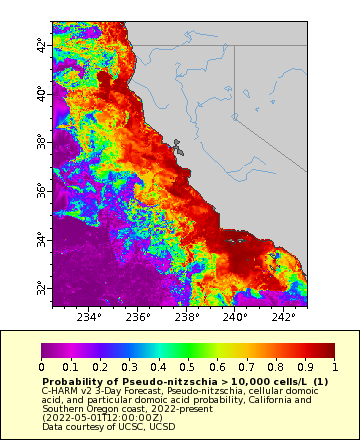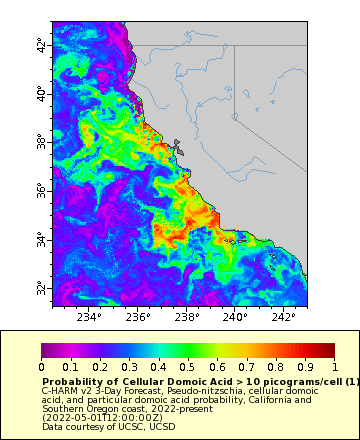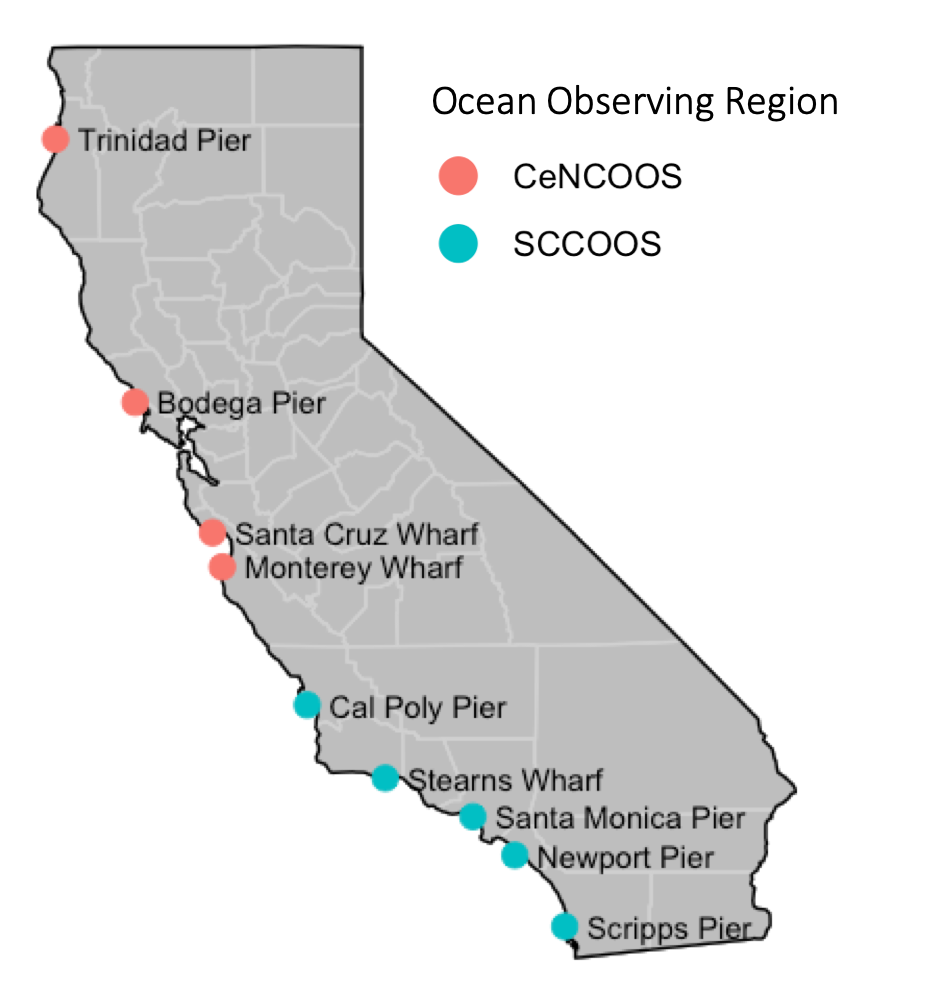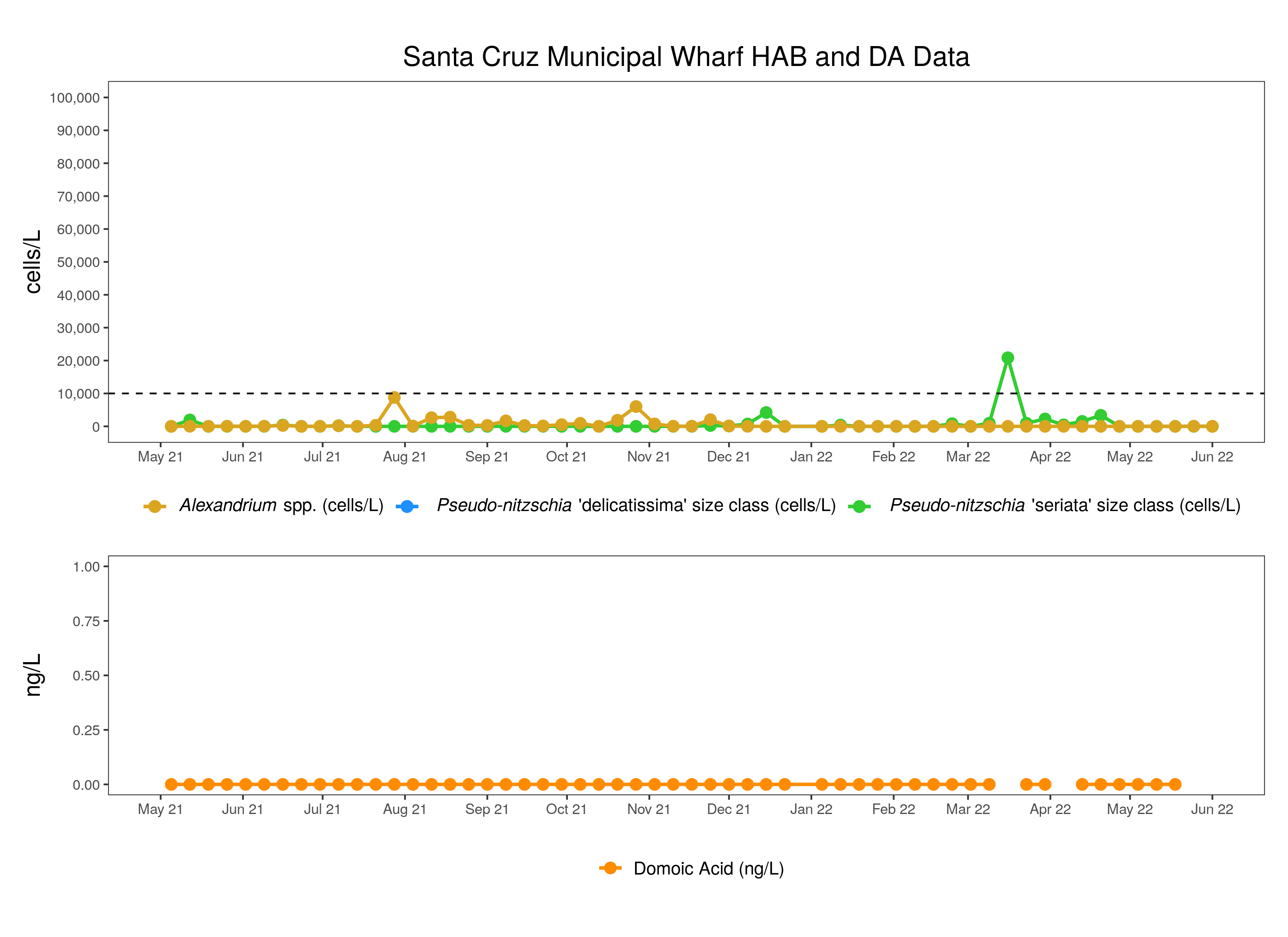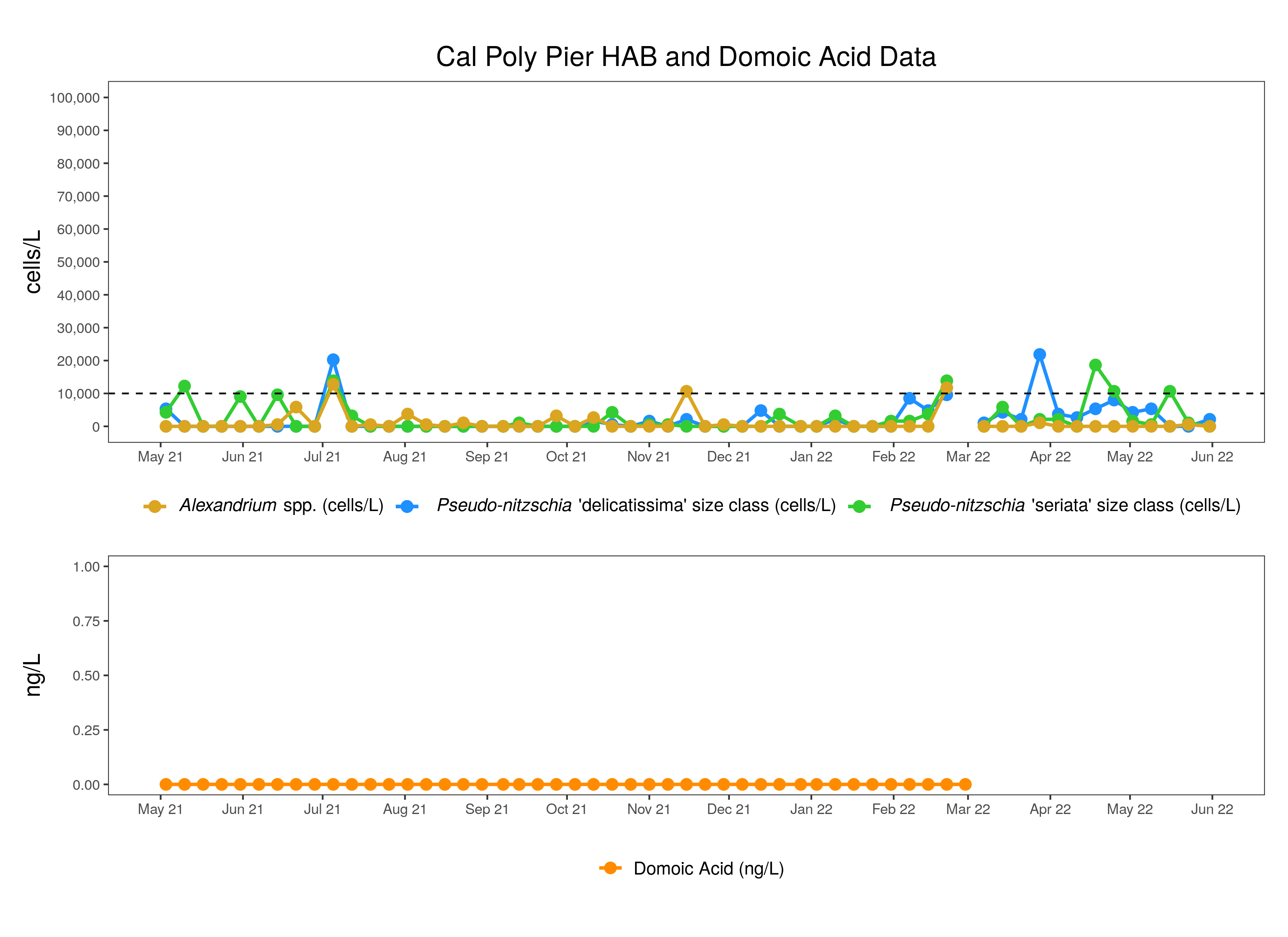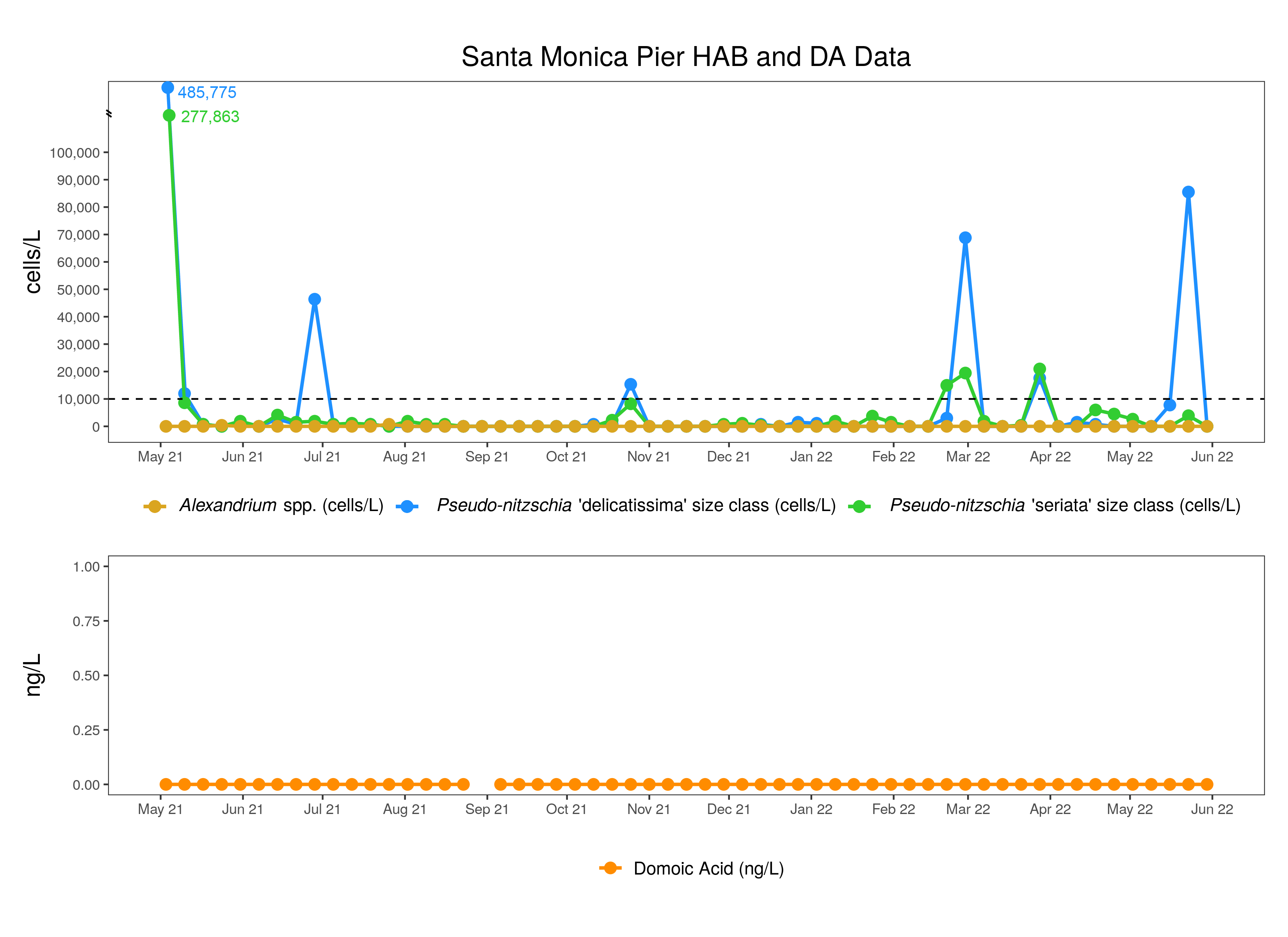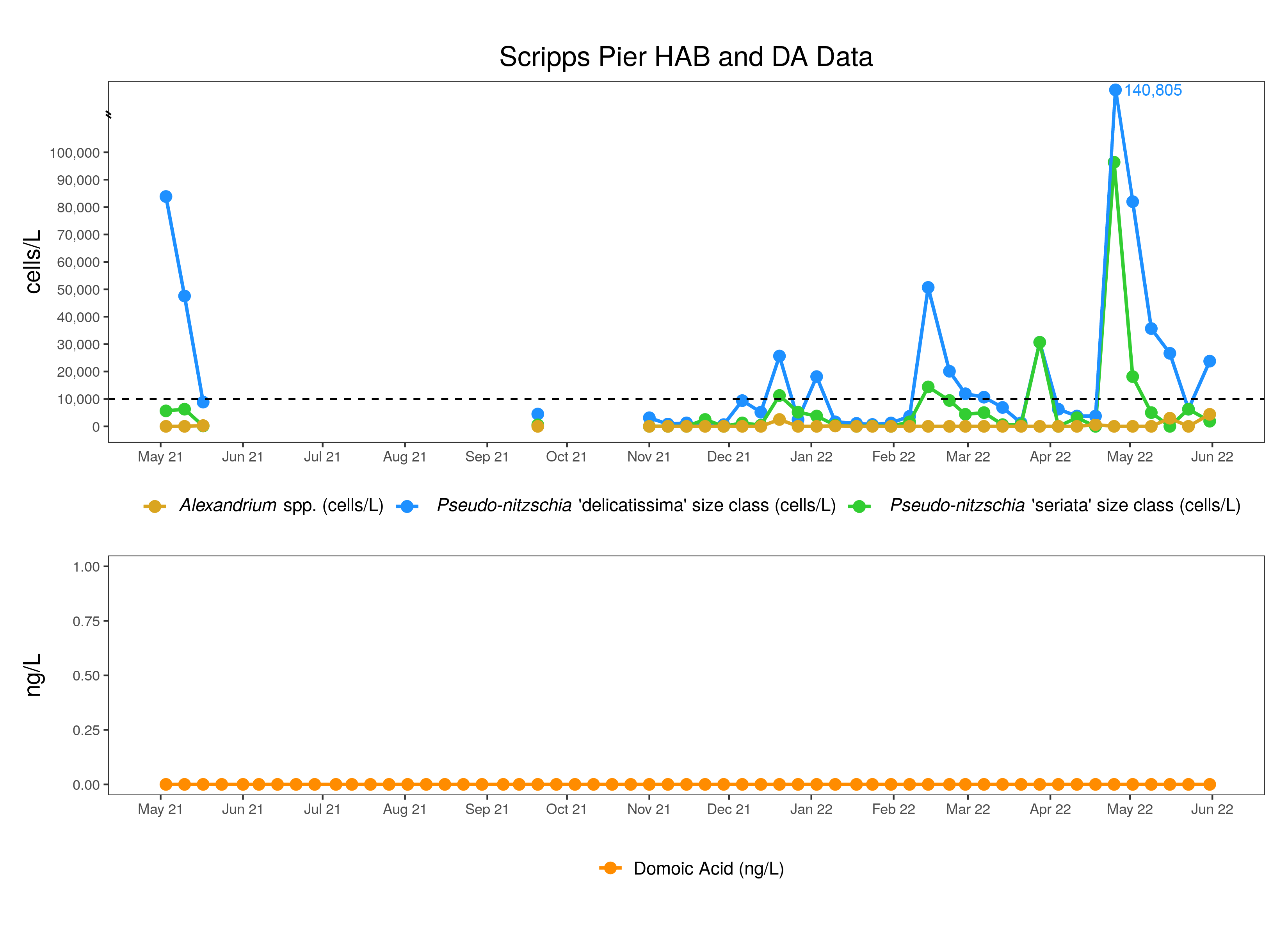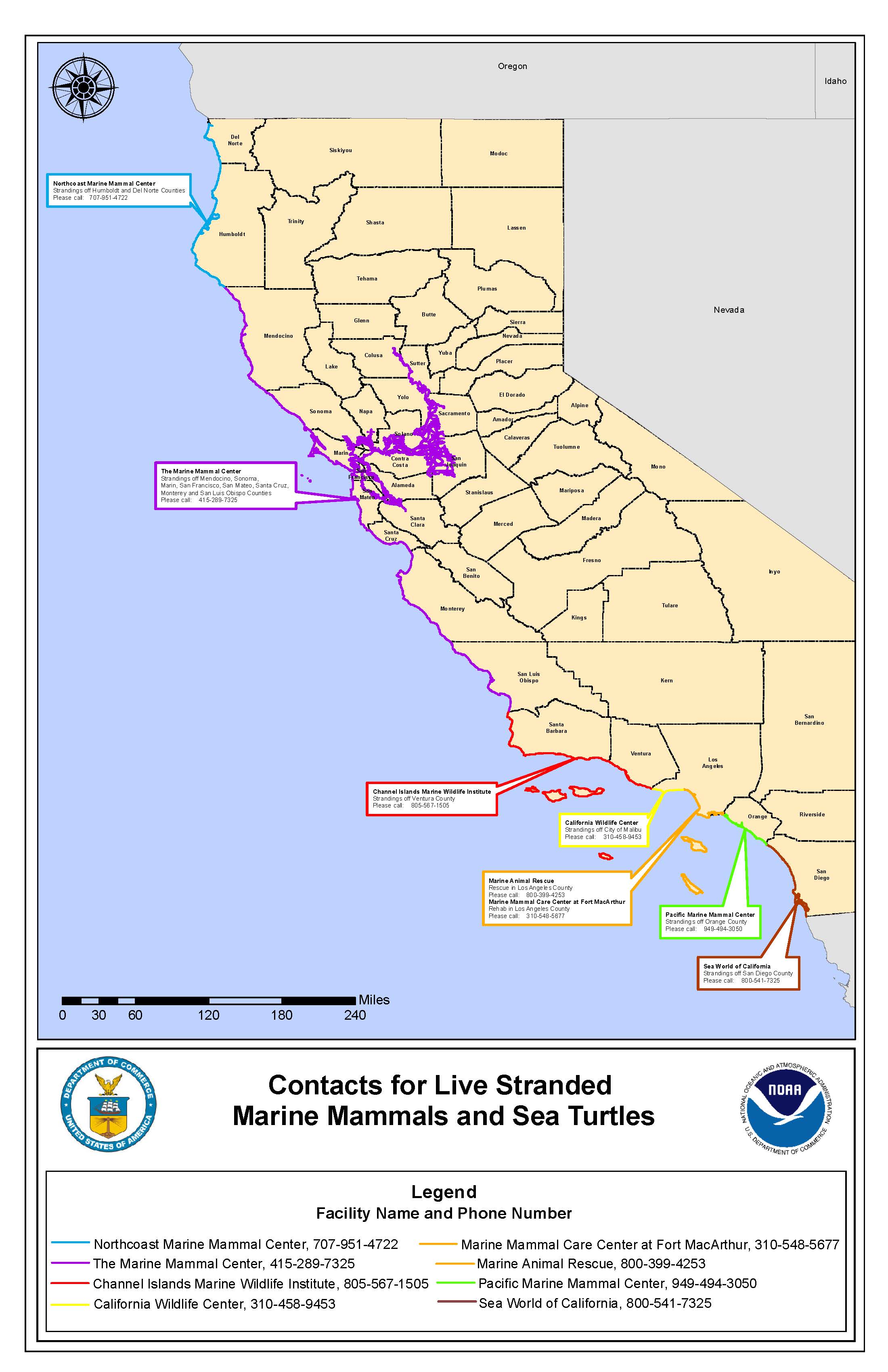MAY HIGHLIGHTS
Pseudo-nitzschia -
- C-HARM tells us where conditions are suitable for species of the diatom Pseudo-nitzschia spp. (all size classes) to grow well and where they might be more likely to produce the deadly neurotoxin, domoic acid (DA).
- C-HARM predictions for Pseudo-nitzschia spp. blooms in May suggested a continuing trend of extensive bloom potential throughout the State and rather far offshore at times. There were some problematic retrievals from the satellite sensor or from the interpolation process that led to seemingly spurious predictions at several points in the month where much of the domain shows 60% probability.
- Mid-month, bloom levels of Pseudo-nitzschia spp. were detected at all HABMAP pier sites except Santa Cruz Wharf, with highest abundances at Scripps Pier throughout May. The toxigenic 'seriata' group bloomed at Newport Beach Pier and (especially) Scripps Pier earlier in May, and in mid-May at Stearns Wharf (Santa Barbara) and Cal Poly Pier (San Luis Obispo). May is generally the height of the spring bloom period when all diatoms, not just Pseudo-nitzschia species, gain periodic dominance with periods of persistent upwelling.
- Pseudo-nitzschia activity from CDPH sampling pointed to possible bloom activity for the 'seriata' group at southern sites, such as Catalina Island and Imperial Beach Pier early in May, as well as the central/northern site, Pacifica Pier, in late May. This is consistent with Pseudo-nitzschia bloom potential throughout the state as predicted by C-HARM but is somewhat inconsistent with the lack of activity at Santa Cruz Wharf. However, note that Santa Cruz Wharf is in an upwelling shadow and is often decoupled from processes within Monterey Bay or on the open coastline (e.g. Pacifica Beach).
- The CA Imaging Flow Cytobot Network snapshot from the Monterey Bay offshore MBARI Power Buoy highlighted for May shows a large bloom of the diatom genus Eucampia, a common and unharmful player in springtime phytoplankton communities in California. Many of the southern California IFCBs were under-going maintenance in May.
- C-HARM probabilities for particulate domoic acid (pDA) in May suggested high DA activity in the Santa Barbara Channel region, which had been growing into a potentially large hot spot all spring. Probabilities for pDA events were high in a narrow swath along most of the state's coastline, waning a bit in Monterey Bay in mid-May, while picking up in large parts of the Southern California Bight towards the end of May.
- The pattern for C-HARM predictions of cellular domoic acid (cDA) probability were similar to pDA for May, although the southern California pattern diverged a bit with very low probabilities for high cDA during much of the month, especially as pDA probabilities increased in the Bight and cDA probabilities bounced between low to mid-range. This suggests that while the Pseudo-nitzschia populations in southern California may have been producing domoic acid and accruing a lot of biomass simultaneously, the per cell DA production may have not been keeping up with the bulk levels of DA present.
- As we have seen for some time, for all the sites where domoic acid data are available from HABMAP pier sites in May, no DA was detected. This does not preclude the production of DA offshore of the pier sites.
- Four potential DA toxicosis cases were reported in May. The three animals that were taken into custody were one California Sea Lion in San Luis Obispo on May 4th (TMMC), one common dolphin on May 15th in San Diego (SeaWorld), and one in Los Angeles (MMCC) on May 9th. A fourth sea lion was suspected of suffering from DA exposure in Malibu (LA County) on May 17th, but evaded capture. This pattern is somewhat the inverse of the Pseudo-nitzschia 'seriata' size class bloom detection at the piers, where highest abundances were detected at Cal Poly Pier on May 16th and at Scripps Pier, Newport Beach Pier, and Los Angeles earlier in the month. C-HARM probabilities of DA are high in the Southern California Bight throughout May but do increase significantly as the month goes on, which is more consistent with the pattern of stranding events.
- CDPH health advisories have been somewhat stable with no new advisories since December, although note the annual quarantine on consuming recreational mussels that went into effect April 26th.
Alexandrium -
- CDPH had only one "Present" measure for Alexandrium spp. in May at Humboldt Bay and Palos Verdes. HABMAP sampling detected Alexandrium spp. at central CA pier sites - Santa Cruz Wharf and Cal Poly pier - and at one southern California site - Scripps Pier - in May. There are currently no advisories for Paralytic Shellfish Poisoning.
*Please note that HABMAP sampling, CDPH sampling, and marine mammal rescues have been greatly reduced in response to COVID-19 safety measures.
Summary written by Clarissa Anderson on July 25, 2022
Note that data for some stations are not shown because they are not yet recorded in the public HABMAP archive.
Differentiating Pseudo-nitzschia species by light microscopy is difficult. For this reason, Pseudo-nitzschia "seriata" does not refer to an actual species but rather the larger size class of Pseudo-nitzschia, which is generally a more toxigenic group of species. Alternatively, Pseudo-nitzschia "delicatissima" refers to the smaller size class that is generally non-toxigenic. The dashed line on the plots demarcates the 10,000 cells/L "bloom" threshold designated here for Pseudo-nitzschia populations only.
More information and data visualizations on the statewide HAB network and forecasting system can be found on the California HABMAP website and on the SCCOOS Harmful Algal Bloom page.
Four water samples were collected at Santa Cruz Wharf in May. Molecular probes for toxigenic Pseudo-nitzschia in the "seriata" class are conducted for this site, and was not detected. Alexandrium spp. were detected once on May 25. Domoic acid was not detected, but one sample is pending.
The Santa Cruz Wharf shore station is supported by CeNCOOS PI Raphael Kudela at UCSC.
Five water samples were collected at Cal Poly Pier in May. Pseudo-nitzschia "delicatissima" was detected three times (May 2, 9, 31), all below the bloom threshold. Pseudo-nitzschia "seriata" was detected on four occasions (May 2, 9, 16, 23), with the May 16 sample above the bloom threshold. Alexandrium spp. were detected once on May 23. Domoic acid results are pending.
Cal Poly Pier shore station is supported by SCCOOS and PIs Ryan Walter and Ally Pasulka at Cal Poly.
Four water samples were collected at Stearns Wharf in May. Pseudo-nitzschia "delicatissima" was detected on each occasion (May 1, 9, 16, 30), with only May 16 above the bloom threshold. Pseudo-nitzschia "seriata" was detected on three occasions (May 1, 16, 30), with May 16 also above the threshold. Alexandrium spp. and domoic acid were not detected.
Stearns Wharf is supported by SCCOOS and PIs Mark Brzezinski and Libe Washburn at UCSB.
Five water samples were collected at Santa Monica Pier in May. Pseudo-nitzschia "delicatissima" was detected twice (May 16, 23) with the last sample above the bloom threshold. Pseudo-nitzschia "seriata" was also detected twice (May 2, 23), below the bloom threshold. Alexandrium spp. and domoic acid were not detected.
The Santa Monica Pier shore station is supported by SCCOOS and PI Rebecca Shipe at UCLA.
Four water samples were collected at Newport Beach Pier in May. Pseudo-nitzschia "delicatissima" was detected on three occasions (May 2, 9, 23) with the first above the bloom threshold. Pseudo-nitzschia "seriata" was detected on May 2 above the bloom threshold. Alexandrium spp. and domoic acid were not detected.
Newport Beach Pier is supported by SCCOOS and PI David Caron at USC.
Five water samples were collected at Scripps Pier in May. Pseudo-nitzschia "delicatissima" was detected on each occasion (May 2, 9, 16, 23, 31), with all samples except May 23 above the bloom threshold. Pseudo-nitzschia "seriata" was detected four times (May 2, 9, 23, 31), with only the first sample above the bloom threshold. Alexandrium spp. were detected twice (May 16, 31). Domoic acid was not detected.
Scripps Pier is supported by SCCOOS and PIs Melissa Carter and Clarissa Anderson at UCSD.
CDPH observations for Pseudo-nitzschia "seriata" and Alexandrium spp.
View the interactive map and data table of California Department of Public Health (CDPH) data from January 2019 to present, developed by SCCOOS, below. Or, view CDPH Toxic Phytoplankton Observations Map with layers of Pseudo-nitzschia and Alexandrium spp. as well as other phytoplankton species observations (in the pop-up windows).
Data are provided by the Environmental Management Branch of the CDPH. Please note, starting in July 2019, CDPH moved to only reporting Pseudo-nitzschia of the seriata complex and not all Pseudo-nitzschia spp. as previously provided.
Please email CDPH at Susan.Paulukonis@cdph.ca.gov for any potential marine HAB-related illness in humans.
From May 1-31 2022, water samples were collected by volunteers and sent to the California Department of Public Health (CDPH) for analysis.
Pseudo-nitzchia "seriata" group was detected in 45 of the 82 samples:
Pseudo-nitzschia "seriata" was detected at "Common" density levels on 4 occasions:
- 2022-05-03 12% Imperial Beach Pier
- 2022-05-08 11% Catalina Island, Avalon Bay
- 2022-05-22 10% Pacifica Pier
- 2022-05-29 15% Pacifica Pier
Pseudo-nitzschia "seriata" was detected at "Present" density levels on 24 occasions:
- 2022-05-02 5.5% La Jolla, Scripps Pier
- 2022-05-04 3% GFNMS, Santa Cruz Line 27E
- 2022-05-04 5% Port San Luis, Diablo Cove
- 2022-05-04 5% GFNMS, Santa Cruz Line 27W
- 2022-05-05 3% GFNMS, Monterey Line 29W
- 2022-05-06 1% Bolsa Chica
- 2022-05-08 3% Pacifica Pier
- 2022-05-09 1% Tomales Bay, Lease #M430-15
- 2022-05-10 1% GFNMS, San Mateo Line 23E
- 2022-05-10 5% GFNMS, San Mateo Line 23W
- 2022-05-12 2% Santa Cruz, Seacliff Pier
- 2022-05-13 2% Port San Luis, Diablo Cove
- 2022-05-15 6% Pacifica Pier
- 2022-05-16 5% Humboldt Bay, Indian Is. Ch.
- 2022-05-18 9% Goleta Pier
- 2022-05-19 2% Morro Bay, North T-Pier
- 2022-05-20 1% Port San Luis, Diablo Cove
- 2022-05-22 5% Palos Verdes, OFFSHORE
- 2022-05-23 1% Ventura, Port Hueneme Pier
- 2022-05-23 2% Malibu Pier
- 2022-05-24 5% Goleta Pier
- 2022-05-27 1% Santa Monica Pier
- 2022-05-27 2% San Simeon Pier
- 2022-05-31 1% Tomales Bay, Lease #M430-15
Pseudo-nitzschia "seriata" was detected at "Rare" density levels on 17 occasions:
- 2022-05-01 0.5% Point Richmond, Ferry Point
- 2022-05-02 0.5% Morro Bay, Boat Launch
- 2022-05-04 0.5% Goleta Pier
- 2022-05-06 0.5% San Simeon Pier
- 2022-05-09 0.5% Humboldt Bay, Indian Is. Ch.
- 2022-05-11 0.5% Santa Cruz Wharf
- 2022-05-11 0.5% Imperial Beach Pier
- 2022-05-12 0.5% GFNMS, Santa Cruz Line 25E
- 2022-05-12 0.5% San Diego Bay
- 2022-05-13 0.5% Drakes Bay, Chimney Rock LBS
- 2022-05-16 0.5% Morro Bay, Boat Launch
- 2022-05-20 0.5% San Francisco, Presidio Pier
- 2022-05-20 0.5% San Diego Bay, U.S. Navy Pier
- 2022-05-23 0.5% Morro Bay, Boat Launch
- 2022-05-25 0.5% Pacific Beach Pier
- 2022-05-27 0.5% Drakes Bay, Chimney Rock LBS
- 2022-05-27 0.5% Bolsa Chica
Alexandrium spp. were detected in 7 of the 82 samples:
Alexandrium spp. were not detected at "Common" density levels.
Alexandrium spp. were detected at "Present" density levels on 2 occasions:
- 2022-05-09 2% Humboldt Bay, Indian Is. Ch.
- 2022-05-13 2% Palos Verdes Rocky Pt Offshore
Alexandrium spp. were detected at "Rare" density levels on 5 occasions:
- 2022-05-04 0.5% Goleta Pier
- 2022-05-11 0.5% Goleta Pier
- 2022-05-20 0.5% San Diego Bay, U.S. Navy Pier
- 2022-05-23 0.5% Malibu Pier
- 2022-05-25 0.5% Pacific Beach Pier
CDPH and OEHHA Health Advisories
April 26. The California Department of Public Health (CDPH) today announced the annual quarantine of sport-harvested mussels gathered along the California coast beginning May 1.
April 2. The California Department of Public Health (CDPH) warned consumers today not to eat raw oysters from British Columbia, Canada because they may be linked to an outbreak of norovirus illnesses in California. Canadian officials continue to investigate the source of norovirus illnesses and have closed multiple growing regions in British Columbia for sanitary contamination.
December 16. The California Department of Public Health (CDPH) is advising consumers not to eat sport-harvested razor clams from Del Norte County due to dangerous levels of naturally occurring domoic acid, also referred to as Amnesic Shellfish Poisoning, being detected.
November 29. The California Department of Public Health (CDPH) has lifted the shellfish safety notification for Dungeness crab caught in state waters from the Sonoma/Mendocino County Line (38° 46.125' N. Latitude) to Point Reyes (38° N. Latitude) in Marin County.
November 5. Due to the detection of elevated levels of domoic acid, a naturally occurring toxin, the California Department of Public Health (CDPH) is warning consumers not to eat the viscera (internal organs) of Dungeness crab caught in coastal waters.
For the latest closures and updates, please visit the CDPH Health Advisories page as a central location of information related to CDPH health advisories. Also available is a map showing the current CDPH Recreational Bivalve Shellfish Advisories (see below).
The HAB-related illness workgroup has developed a new webpage for marine HAB-related illness tracking work (https://oehha.ca.gov/fish/general-info/marine-harmful-algal-bloom-hab-related-illness-tracking).
A network of Imaging FlowCytobots (IFCBs) continuously photographs particles, such as plankton, in the water. Using machine learning, plankton species can be automatically identified. This will help improve the ability to detect and respond to Harmful Algal Blooms, including the ability to assess conditions that may lead to toxin production or blooms of toxin-producing algae.
Additional images and data are available on the IFCB dashboard.
A diatom bloom, dominated by Eucampia, was detected at the MBARI Power Buoy in May.
Domoic acid (DA) is a potent neurotoxin produced by some diatom species of the genus Pseudo-nitzschia. Species exposed to DA can result in seizures, epilepsy, cardiomyopathy, and death depending upon the ingested dose. DA toxicosis commonly occurs in California Sea Lions (Zalophus californianus), presumably due to a combination of foraging behavior and seasonal movements. The Marine Mammal Center (TMMC), Channel Islands Marine Wildlife Institute (CIMWI), California Wildlife Center (CWC), Marine Mammal Care Center Los Angeles (MMCC-LA), Marine Animal Rescue (MAR), the Pacific Marine Mammal Center (PMMC), SeaWorld, and Southwest Fisheries Science Center (SWFSC) act like an emergency room by working to rescue and rehabilitate sick and injured marine mammals, seabirds, and sea turtles.
CIMWI and SWFSC did not record any strandings due to suspected domoic acid in May 2022. Results from PMMC and MAR are pending.
May strandings due to suspected DA toxicosis occurred in the following counties:
- San Luis Obispo (TMMC)
- May 4 - Adult, female, California Sea Lion
- San Diego (SeaWorld)
- May 15 - Adult, female, Short beaked common dolphin
MMCC-LA reported an adult male California Sea Lion that stranded on May 9th with symptoms indicating a possible previous DA exposure, but was released May 26th after recovering.
CWC reported an adult female California Sea Lion that had suspected DA exposure on May 17 in Malibu, but escaped recovery.
Beginning on May 13th, the California Department of Fish and Wildlife (CDFW), along with the U.S. Fish and Wildlife Service (USFWS), and wildlife rehabilitation facilities admitted 700 pelicans for rehabilitation. Necropsies by CDFW biologists suggested the most likely cause of stranding and death was starvation and no direct link to harmful algal blooms: https://wildlife.ca.gov/News/cdfw-provides-update-on-california-brown-pelican-stranding-event

